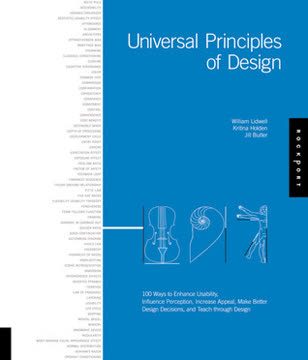Key Takeaways
1. Design Principles: Universal Laws for Effective Creation
"Sound design is not only within the reach of a small set of uniquely talented individuals, but can be achieved by virtually all designers."
Universal principles. Design principles are not mysterious talents possessed by a gifted few, but learnable concepts that can be applied across various disciplines. These principles serve as a foundation for creating effective, user-friendly designs in any field.
Cross-disciplinary knowledge. Understanding and applying these universal principles allows designers to:
- Increase their cross-disciplinary knowledge
- Promote brainstorming and idea generation
- Refresh their memory of infrequently applied principles
- Check the quality of their design process and product
By mastering these principles, designers can create more intuitive, functional, and appealing products, whether they're working on physical objects, digital interfaces, or complex systems.
2. Perception and Psychology: Shaping User Experience
"People understand and interact with systems and environments based on mental representations developed from experience."
Mental models. Users approach new systems with preconceived notions based on their past experiences. Designers must understand and leverage these mental models to create intuitive interfaces and experiences.
Psychological principles in design:
- Gestalt principles (e.g., proximity, similarity, closure) guide visual organization
- Color psychology influences user emotions and behaviors
- Cognitive biases affect user decision-making and preferences
By aligning designs with users' existing mental models and leveraging psychological principles, designers can create more intuitive and engaging experiences. This approach reduces the learning curve for users and increases the likelihood of product adoption and satisfaction.
3. Cognitive Load and Information Processing
"The time it takes to make a decision increases as the number of alternatives increases."
Cognitive limitations. Human brains have finite processing capacity, and overloading users with information or choices can lead to decision paralysis or errors.
Strategies for managing cognitive load:
- Chunking: Group related information into manageable units
- Progressive disclosure: Reveal information gradually as needed
- Hierarchical organization: Structure information in logical levels
- Recognition over recall: Provide visual cues rather than relying on memory
By respecting cognitive limitations and employing these strategies, designers can create interfaces and systems that are easier to learn, use, and remember. This approach leads to increased efficiency, reduced errors, and improved user satisfaction.
4. Aesthetics and Usability: The Interplay of Form and Function
"Aesthetic designs are perceived as easier to use than less-aesthetic designs—whether they are or not."
Aesthetic-usability effect. Visual appeal influences perceived usability, even when it doesn't affect actual performance. This phenomenon highlights the importance of balancing form and function in design.
Balancing aesthetics and functionality:
- Use consistent visual language to enhance usability
- Employ the golden ratio and other aesthetic principles for pleasing proportions
- Ensure that aesthetic elements don't interfere with core functionality
- Test designs with users to verify that aesthetics enhance rather than hinder usability
By creating designs that are both visually appealing and functionally sound, designers can improve user perception, engagement, and overall satisfaction with their products or systems.
5. Hierarchy and Organization: Structuring Complex Systems
"Hierarchical organization is the simplest structure for visualizing and understanding complexity."
Simplifying complexity. Hierarchical structures help users navigate and comprehend complex systems by breaking them down into manageable levels and categories.
Effective hierarchical design:
- Use clear visual cues to indicate relationships between elements
- Employ consistent naming conventions and categorization
- Provide overview maps or sitemaps for large systems
- Allow users to easily move between levels of the hierarchy
By implementing clear hierarchies, designers can make even the most complex systems more approachable and usable. This organization aids in information retrieval, decision-making, and overall system comprehension.
6. User-Centered Design: Meeting Human Needs and Expectations
"In order for a design to be successful, it must meet people's basic needs before it can attempt to satisfy higher-level needs."
Hierarchy of needs. Successful designs address user needs in a specific order, starting with basic functionality and progressing to more advanced features.
Levels of user needs:
- Functionality: The design must work as intended
- Reliability: Performance should be consistent and dependable
- Usability: The design should be easy to use and learn
- Proficiency: Advanced features should empower expert users
- Creativity: The highest level allows for innovative use and personalization
By focusing on meeting user needs in this hierarchical manner, designers can create products that not only function well but also provide a satisfying and empowering user experience. This approach ensures that the most critical aspects of a design are addressed before moving on to more advanced features.
7. Iteration and Feedback: Continuous Improvement in Design
"Quality design does not occur without iteration."
Iterative process. Great designs rarely emerge fully formed; they evolve through repeated cycles of creation, testing, and refinement.
Key aspects of effective iteration:
- Prototyping: Create quick, low-fidelity models to test ideas
- User testing: Gather feedback from actual users throughout the process
- Data analysis: Use quantitative and qualitative data to inform decisions
- Flexibility: Be willing to pivot or make significant changes based on feedback
By embracing an iterative approach, designers can identify and address issues early in the process, leading to more refined and effective final products. This method also allows for adaptation to changing user needs and technological advancements.
8. Simplicity and Clarity: The Power of Minimalism
"Given a choice between functionally equivalent designs, the simplest design should be selected."
Occam's Razor in design. Simplicity is not just an aesthetic choice; it often leads to more usable and effective designs by reducing cognitive load and potential points of failure.
Achieving simplicity:
- Remove unnecessary elements and features
- Use clear, concise language in interfaces and instructions
- Employ consistent design patterns and visual language
- Prioritize core functionality over "nice-to-have" features
By striving for simplicity and clarity, designers can create more intuitive, efficient, and maintainable products. This approach often leads to designs that are not only easier to use but also more elegant and timeless.
9. Storytelling and Engagement: Captivating User Attention
"Storytelling is uniquely human. It is the original method of passing knowledge from one generation to the next, and remains one of the most compelling methods for richly communicating knowledge."
Narrative power. Incorporating storytelling elements into design can create more engaging and memorable user experiences.
Elements of effective storytelling in design:
- Setting: Provide context and orient the user
- Characters: Create relatable personas or user journeys
- Plot: Develop a logical flow or progression through the experience
- Emotion: Evoke feelings that resonate with users
- Resolution: Provide clear outcomes or calls to action
By weaving narrative elements into their designs, creators can make products and experiences more immersive, understandable, and impactful. This approach can be particularly effective in educational software, marketing campaigns, and user onboarding processes.
10. Accessibility and Inclusivity: Designing for All Users
"Objects and environments should be designed to be usable, without modification, by as many people as possible."
Universal design. Creating products and environments that are accessible to people with diverse abilities benefits all users and expands the potential audience for a design.
Key principles of accessible design:
- Perceptibility: Ensure information can be perceived regardless of sensory abilities
- Operability: Allow for use by people with various physical capabilities
- Simplicity: Make designs easy to understand regardless of experience or cognitive ability
- Forgiveness: Minimize the occurrence and consequences of errors
By prioritizing accessibility and inclusivity from the outset, designers can create products that are not only more ethical but often more usable and versatile for all users. This approach can lead to innovative solutions that improve the experience for everyone, not just those with specific disabilities.
Last updated:
FAQ
What's Universal Principles of Design about?
- Cross-disciplinary design knowledge: The book offers a comprehensive reference of design principles from various fields, making it accessible for designers to apply knowledge across disciplines.
- 100 key principles: It includes 100 principles covering laws, guidelines, human biases, and general design considerations, organized alphabetically for easy reference.
- Practical application: Each principle is presented with definitions, examples, and guidelines, serving as a practical resource for enhancing design processes and outcomes.
Why should I read Universal Principles of Design?
- Enhance design skills: The book can significantly improve your understanding of design principles, leading to more effective and aesthetically pleasing designs.
- Broaden knowledge base: It helps designers become aware of advances in other design disciplines, fostering a holistic approach to problem-solving.
- Resource for brainstorming: The book serves as a valuable resource for idea generation and refreshing memory on infrequently applied design principles.
What are the key takeaways of Universal Principles of Design?
- Usability is crucial: Emphasizes that usability is a critical aspect of design, with principles like the Aesthetic-Usability Effect showing how aesthetics influence perceived usability.
- Focus on accessibility: Stresses the need for designs to be accessible to a diverse range of users, enhancing overall user experience and satisfaction.
- Iterative design process: The Development Cycle principle highlights the importance of iterative processes in design, ensuring products evolve based on user feedback and testing.
What is the 80/20 Rule in Universal Principles of Design?
- Key concept: The 80/20 Rule states that approximately 80% of effects in a system are caused by 20% of the variables, emphasizing focus on critical features.
- Resource allocation: Suggests designers prioritize resources on the most impactful features to maximize efficiency and effectiveness in design.
- Real-world applications: Examples include focusing on the 20% of product features used 80% of the time, leading to better design decisions and user satisfaction.
How does Universal Principles of Design define accessibility?
- Usability for all: Accessibility is designing objects and environments to be usable by as many people as possible, without modification.
- Four characteristics: The book outlines perceptibility, operability, simplicity, and forgiveness as key characteristics of accessible designs.
- Broader benefits: While initially focused on accommodating disabilities, accessible design principles benefit all users, promoting inclusivity and usability.
What is the Aesthetic-Usability Effect in Universal Principles of Design?
- Perception of ease: Describes how aesthetically pleasing designs are often perceived as easier to use, regardless of actual usability.
- Influence on acceptance: Suggests users are more likely to accept and engage with aesthetically pleasing designs, leading to better user experiences.
- Long-term implications: Positive initial impressions can foster loyalty and patience with design flaws, making aesthetics crucial in design.
What does Universal Principles of Design say about the principle of affordance?
- Definition of affordance: Affordance refers to properties of an object that suggest its function, influencing use based on physical characteristics.
- Design efficiency: When affordance aligns with intended function, it enhances usability and efficiency, making designs easier to interact with.
- Conflict in design: Warns against designs where affordances conflict with intended functions, as this can lead to confusion and errors in use.
How does Universal Principles of Design explain cognitive dissonance?
- Mental discomfort: Cognitive dissonance is the discomfort experienced when beliefs or attitudes conflict with actions or new information.
- Alleviating dissonance: Outlines ways to alleviate cognitive dissonance, such as changing beliefs or minimizing the importance of conflicting beliefs.
- Application in design: Understanding cognitive dissonance helps designers create marketing strategies that effectively influence consumer behavior.
What is the significance of the Development Cycle in Universal Principles of Design?
- Four stages: The Development Cycle consists of requirements, design, development, and testing, essential for creating successful products.
- Iterative process: Emphasizes feedback and iteration at each stage to refine the product and ensure it meets user needs effectively.
- Maximizing success: Following the Development Cycle enhances the probability of success through careful planning and execution.
What are some best practices for using color in design according to Universal Principles of Design?
- Conservative use of color: Advises limiting the color palette to about five colors to avoid overwhelming users and enhance visual clarity.
- Contrast and combinations: Emphasizes using contrasting colors for text and backgrounds to improve readability and aesthetic appeal.
- Cultural considerations: Designers should verify the significance of colors for the target audience, as meanings can vary across cultures.
What are some important concepts in Universal Principles of Design?
- Mimicry: Involves copying familiar properties of objects to enhance usability, serving as a powerful tool for improving user experience.
- Modularity: Refers to breaking down complex systems into smaller modules, enhancing flexibility and maintainability.
- Performance Load: Highlights that higher effort in completing a task often leads to lower success rates, suggesting reducing cognitive and kinematic loads.
What are the best quotes from Universal Principles of Design and what do they mean?
- "Designers generally have very complete and accurate system models, but often have weak interaction models.": Highlights the gap between designers' understanding of systems and users' experiences.
- "The simplest design should be selected.": Encapsulates Ockham’s Razor, advocating for simplicity in design choices.
- "Pictures are remembered better than words.": Emphasizes the Picture Superiority Effect, underscoring the power of visual communication in design.
Review Summary
Universal Principles of Design receives mostly positive reviews, with readers praising its informative content and practical applications across various design fields. Many find it a valuable reference for both beginners and experienced designers. The book's layout, with concise explanations and visual examples, is widely appreciated. Some readers note that certain principles overlap or seem obvious, while others find the alphabetical organization less than ideal. Overall, it's considered a comprehensive guide to design principles, offering insights into psychology, user experience, and effective communication.
Similar Books










Download PDF
Download EPUB
.epub digital book format is ideal for reading ebooks on phones, tablets, and e-readers.




